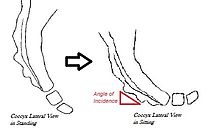User:Ecrice91
Mechanism of Coccydynia
[edit]Causes of Coccydynia
[edit]Although one-third of cases are idiopathic, many cases of coccydynia are caused by trauma which is classified as being acute—caused by a sudden injury—or chronic and repetitive in origin [1]. As explained by Mitra, Cheung, & Perry [2], causes of coccydynia include: trauma, immobilization of the sacrococcygeal joint, existence of coccygeal spicules, and degeneration due to age or overweight.

Angle of Incidence
[edit]Saggital coccygeal movement is measured using the angle of incidence—or the angle at which the coccyx strikes the seat when an individual sits down [3]. A smaller angle indicates the coccyx being more parallel to the seat, resulting in flexion (or “normal” movement) of the coccyx [4]. A larger angle indicates the coccyx being more perpendicular to the seat, causing posterior subluxation(or “backward” movement) of the coccyx [5].

Coccydynia Mechanisms of Injury
[edit]Coccydynia is caused by abnormal movement or lack of movement of the coccyx [6]. The most common mechanism of coccydynia is backward movement of the coccyx, associated with overweight and trauma [7]. Specifically, greater Body Mass Index (BMI) allows for less ability of the pelvis to sagitally rotate upon sitting; thus, there is a larger angle of incidence comparable to that experienced from a fall [8]. Thus, a person who is overweight or experiences a fall could experience abnormal extension and possible posterior dislocation of the coccyx, causing coccydynia [9]. The second most common mechanism of coccydynia is coccygeal hyperflexion, which is associated with normal or low BMI values. Subjects with lean BMI are able to rotate the pelvis upon sitting, which tucks the tailbone into the pelvis to ideally protect the coccyx [10]. However, flexion past the optimum level causes coccydynia [11]. The final mechanism of coccydynia is coccyx immobility, which is related to spicules—bony nodules on the dorsal side of the coccyx that prevent the intercoccygeal joints from moving normally [12].
- ^ Woon, J. , & Stringer, M. (2012). Clinical anatomy of the coccyx: A systematic review. Clin Anat, 25(2), 158-167.
- ^ Mitra, R. , Cheung, L. , & Perry, P. (2007). Efficacy of fluoroscopically guided steroid injections in the management of coccydynia. Pain Physician, 10(6), 775-778.
- ^ Maigne, J., Doursounian, L., & Chatellier, G. (2000). Causes and mechanisms of common coccydynia: role of body mass index and coccygeal trauma. SPINE, 25(23), 3072-3079.
- ^ Maigne, J., Doursounian, L., & Chatellier, G. (2000). Causes and mechanisms of common coccydynia: role of body mass index and coccygeal trauma. SPINE, 25(23), 3072-3079.
- ^ Maigne, J., Doursounian, L., & Chatellier, G. (2000). Causes and mechanisms of common coccydynia: role of body mass index and coccygeal trauma. SPINE, 25(23), 3072-3079.
- ^ Maigne, J., Doursounian, L., & Chatellier, G. (2000). Causes and mechanisms of common coccydynia: role of body mass index and coccygeal trauma. SPINE, 25(23), 3072-3079.
- ^ Maigne, J., Doursounian, L., & Chatellier, G. (2000). Causes and mechanisms of common coccydynia: role of body mass index and coccygeal trauma. SPINE, 25(23), 3072-3079.
- ^ Maigne, J., Doursounian, L., & Chatellier, G. (2000). Causes and mechanisms of common coccydynia: role of body mass index and coccygeal trauma. SPINE, 25(23), 3072-3079.
- ^ Maigne, J., Doursounian, L., & Chatellier, G. (2000). Causes and mechanisms of common coccydynia: role of body mass index and coccygeal trauma. SPINE, 25(23), 3072-3079.
- ^ Maigne, J., Doursounian, L., & Chatellier, G. (2000). Causes and mechanisms of common coccydynia: role of body mass index and coccygeal trauma. SPINE, 25(23), 3072-3079.
- ^ Maigne, J., Doursounian, L., & Chatellier, G. (2000). Causes and mechanisms of common coccydynia: role of body mass index and coccygeal trauma. SPINE, 25(23), 3072-3079.
- ^ Maigne, J., Doursounian, L., & Chatellier, G. (2000). Causes and mechanisms of common coccydynia: role of body mass index and coccygeal trauma. SPINE, 25(23), 3072-3079.
Text is available under the CC BY-SA 4.0 license; additional terms may apply.
Images, videos and audio are available under their respective licenses.
